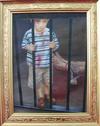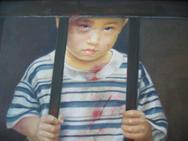Introductory Note: On July 15-16, 2004, an art exhibition sponsored by the Falun Dafa Association of Washington, D.C. with the theme of "Uncompromising Courage," was held in the exhibition hall of Rayburn House Office Building in Washington, D.C. Falun Gong practitioners created all the art works in the exhibits. Some of the artists are still illegally imprisoned in China. After five years of bloody suppression, these Falun Gong artists hope to express the joy of returning to one’s true nature through cultivating Falun Gong, their indestructible righteous beliefs under cruel tortures and suppression, their persistence in pursuing Truthfulness-Compassion-Forbearance, and their faith in “justice will defeat evil eventually.” These artists each have their merits. They have tried to use the traditional methods to achieve their goals. We will continue to introduce the works of these artists, the ideas behind their works and their creation processes.
 |
| Oil Painting “WHY?” by Weixing Wang (26in x 20in.), 2004 |
Reporter: Zhu, Qingming, a reporter for PureInsight Net
Wang: Ms. Wang, Weixing, artist
Reporter: The “WHY?” painting has attracted a lot of attention. Many people who saw the little boy’s eyes and facial expression all said that it was very touching. Could you talk about the story behind the painting?
Wang: I didn’t give much thought to the painting. I met a friend of mine one day, who also practises Falun Gong, and she told me her story. She and her son were imprisoned in jail like this. After listening to her story, I started painting without giving it much thought because it was a true story. I was not used to painting children who were dirty, ragged, and beaten, so I was scared to paint something like that. The boy I started out painting was clean and had flawless complexion. I did paint the clothes to look dirty but it still didn’t look right because this was in jail and they had beaten him and his mother. I later tried adding some effects to the eye to show ruptured eye vessels from being beaten. The mother came and told me that I needed to add some tears, not rolling down the face, but just so the eyes looked moist. I didn’t have a model so she showed me what she meant. Later this was added, I realised that with the eyes been so bright, the tears were not very obvious. After adding [the effect of the ruptured vessels], the white of the eye became darker and the small amount of tears became clearer. The tear wasn't shown to be rolling down the face because boys don't act like girls otherwise he might of cried for ever. His expression is not that simple. He keeps asking, “Why? Why?” He doesn’t understand why he and his mother are imprisoned, why his mother is beaten, why he is been beaten, why they have to be imprisoned and are not allowed to be released. He stands there with his feet pointing one way and his hands another way, looking like he wants to get out but can’t.
 |
| Detail from Wang Weixing’s Oil Painting “WHY?” |
Reporter: Exactly. It’s apparent that the child is in that state of bafflement and confusion. The depiction is very realistic. You mentioned that you had often painted children who were very clean. Then was it rather difficult to paint a child covered with bruises and blood?
Wang: Yes, it was. I’m used to painting beautiful things. But I know that with a child standing inside a jail cell and a mother having been beaten into that state, his being nice and clean would not be realistic. In addition, the mother specifically told me so when she came to look at the painting. So I gave it a try.
Reporter: You showed only the feet of the mother. What gave you the idea to show such a small part to depict the mother having been beaten and lying on the floor motionless?
Wang: In the past, I often thought of painting pictures in their entirety. When telling a story, it’s necessary to paint a complete picture. A while back, I went to the Metropolitan Museum of Art and saw one of Havarotti’s paintings. It was a painting of Christ bearing the cross and the people beside Him were beating Him. I had been thinking about the issue of not painting a big painting, but rather a small painting to allow people to focus on one point. But because most of the paintings I had seen before were all complete paintings, I didn’t know if what I did was good or not. It just so happened that at the museum, the painting that attracted me the most was of Christ bearing a cross and with tears rolling down His face. The people beside Him had only their heads shown depicting their expressions, just like cutting a piece out of a photograph. Later I thought if those people had their bodies painted, then it wouldn’t have attracted me that much. Because I directly focused in on Christ’s face, the painting was very life-like and the tears were very realistic. It was very touching. It made me realise that what I wanted to do wasn’t wrong, and that what I wanted to do would allow the audience to focus in on the child’s face. This was also enough to portray the mother having been beaten and couldn’t move.
Reporter: This painting of yours specifically focused on certain parts with fine details to express a theme. I think that this is why it has attracted many people.
Wang: I wanted people’s eyes to immediately focus in on what I wanted to convey.
Reporter: You’ve painted the child in very fine detail. With the child’s eyes and expression, the painting has very fine details. Is it because of your love for painting children that you understand more of their facial expressions and feelings?
Wang: I do not only paint children. I like to paint any people. I even paint the elderly. Maybe it’s because I like to find out about people’s inner thoughts. This does not entirely belong to art, but also to literature.
* * *
You are welcome to print and circulate all articles published on Clearharmony and their content, but please quote the source.










 more ...
more ...